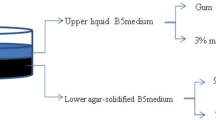Summary
Anthers of 55 different spring barley (Hordeum vulgare) hybrids and four varieties were cultured in vitro. Microspores of each hybrid gave rise to calluses and subsequently plantlets, from all hybrids, except one. As criteria of microspore responsiveness, callus formation and plant regeneration frequencies were studied in detail. Large differences with regard to these criteria were found, which were traced back to the genotype of the anther donor plant. Callus formation varied between 3.3 and 73.2 per 1,000 anthers plated, whereas green plant regeneration ranged from 0 to 12.7 per 1,000 anthers cultured.
Comparisons of microspore regeneration frequencies of hybrids and their parents indicated that culture responsiveness is a heritable, complex character involving at least two different and separately inherited mechanisms:
-
1)
the ability of microspores within anthers to divide and give rise to calluses and subsequently
-
2)
the ability of calluses for morphogenesis, to yield green or albino plants.
Because it is heritable, anther culture responsiveness can be transferred to breeding material which is initially non-responsive. This genetic way of improving success in androgenetic haploid production appears to be more realistic than the search for optimum culture conditions.
Similar content being viewed by others
Literature
Chen, Y.; Li, L.T. (1978): Investigation and utilization of pollen-derived haploid plants in rice and wheat. In: Proc. of Symp. on Plant Tissue Culture pp. 199–212. Peking, China: Science Press
Deaton, W.R.; Legg, P.D.; Collins, G.B. (1982): A comparison of hurley tobacco doubled-haploid lines with their source inbred cultivars. Theor. Appl. Genet, (in press)
Dunwell, J.M. (1982): Development of zygotic barley embryos in vitro. In: Proc. Int. Symp. Plant Cell Culture in Crop Improvement (eds.: Sen, S.K.; Giles, K.L.). Bose Institute, Calcutta (in press)
Foroughi-Wehr, B.; Friedt, W. (1981) Responsiveness to anther culture of Hordeum vulgare cv. ‘Dissa’ and its parents. Barley Genet. Newsl. 11, 50–53
Foroughi-Wehr, B.; Mix, G. (1979): In vitro response of Hordeum vulgare L. anthers cultured from plants grown under different environments. Environ. Exp. Bot. 19, 303–309
Foroughi-Wehr, B.; Mix, G.; Gaul, H.; Wilson, H.M. (1976): Plant production from cultured anthers of Hordeum vulgare L. Z. Pflanzenzücht. 77, 198–204
Hagberg, A.; Hagberg, G. (1980): High frequency of spontaneous haploids in the progeny of an induced mutation in barley. Hereditas 93, 341–343
Kao, K.N. (1981): Plant formation from barley anther cultures with Ficoll media. Z. Pflanzenphysiol. 103, 437–443
Kasha, K.J.; Reinbergs, E. (1980): Achievements with haploids in barley research and breeding. In: The Plant Genome (eds.: Davies, D.R.; Hopwood, D.A.), pp. 215–230. Norwich, UK: John Innes Charity
Kermicle, J.L. (1969): Androgenesis conditioned by a mutation in maize. Science 166, 1422–1424
Liang, C.; Chou, Y.; Chen, W. (1978): A study of submicroscopic structure and metabolic blocks in the albino anther plant of rice. In: Proc. of Symp. on Plant Tissue Culture pp. 161–166. Peking, China: Science Press
]Mendiburu, A.O.; Peloquin, S.J.; Mok, D.W.S. (1974): Potato breeding with haploids and 2n gametes. In: Haploids in Higher Plants (ed. Kasha, K.J.), pp. 249–258. Guelph, Ontario, Canada: University of Guelph
Nakamura, A.; Itagaki, R.; Kobayashi, K. (1973): Studies on breeding tobacco by haploidy utilizing anther culture. III. Expression of resistance to some diseases in haploid plants. Bull. Iwata Tobacco Exp. Sta. 5, 121–128
Picard, E.; de Buyser, J. (1973): Obtention de plantules haploides de Triticum aestivum L. á partir de culture d'anthéres in vitro. C.R. Acad. Sci. (Paris) 277 D, 777–780
Sachs, L. (1974): Angewandte Statistik. Springer: Berlin-Heidelberg-New York
Wang, C.; Sun, C.; Chu, C.; Wu, S. (1978): Studies on the albino pollen plantlets of rice. In: Proc. of Symp. on Plant Tissue Culture pp. 149–160. Peking, China: Science Press
Wenzel, G.; Hoffmann, F.; Thomas, E. (1977): Increased induction and chromosome doubling of androgenetic haploid rye. Theor. Appl. Genet. 51, 81–86
Wenzel, G.; Uhrig, H. (1981): Breeding for nematode and virus resistance in potato via anther culture. Theor. Appl. Genet. 59, 333–340
Xu, Z.H.; Huang, B.; Sunderland, N. (1981): Culture of barley anthers in conditioned media. J. Exp. Bot. 32, 767–778
Author information
Authors and Affiliations
Additional information
Communicated by H. F. Linskens
Rights and permissions
About this article
Cite this article
Foroughi-Wehr, B., Friedt, W. & Wenzel, G. On the genetic improvement of androgenetic haploid formation in Hordeum vulgare L.. Theoret. Appl. Genetics 62, 233–239 (1982). https://doi.org/10.1007/BF00276246
Received:
Issue Date:
DOI: https://doi.org/10.1007/BF00276246




